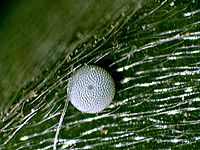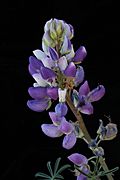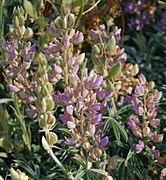Mission blue butterfly facts for kids
Quick facts for kids Icaricia icarioides missionensis |
|
|---|---|
 |
|
 |
|
| Conservation status | |
| Scientific classification |
|
| Kingdom: | Animalia |
| Phylum: | Arthropoda |
| Class: | Insecta |
| Order: | Lepidoptera |
| Family: | Lycaenidae |
| Genus: | Icaricia |
| Species: | |
| Subspecies: |
I. i. missionensis
|
| Trinomial name | |
| Icaricia icarioides missionensis (Hovanitz, 1937)
|
|
| Synonyms | |
|
|
The Mission blue (Icaricia icarioides missionensis) is a small, beautiful butterfly. It is a type of blue butterfly found only in the San Francisco Bay Area of the United States. This butterfly is a special kind, or subspecies, of the Boisduval's blue butterfly.
Because it is so rare, the Mission blue butterfly has been listed as an endangered species by the U.S. federal government. This means it needs special protection to survive.
Contents
About the Mission Blue Butterfly
The Mission blue butterfly is quite small. Its wingspan is about 21–33 millimetres (0.83–1.3 in) wide. The tiny baby butterflies, called larvae or caterpillars, are very hard to spot.
Male Mission blue butterflies have stunning wings. The top of their wings changes from a light ice blue in the middle to a deep sky blue at the edges. In sunlight, these colors shimmer and change, looking very bright and pure blue. Their upper wings also have black edges with long, white, hair-like scales.
The underside of their wings is silvery and shiny. It has a pattern of black dots that stand out against the light background. A faint hint of dark ice blue can be seen near their bodies and along the wing veins. Male butterflies have dark blue-brown bodies. Female Mission blue butterflies have dark brown upper wings, but their undersides look similar to the males'.
What Mission Blue Butterflies Eat
When they are caterpillars, Mission blue butterflies are very picky eaters! They only eat the leaves of three specific plants:
- Silver lupine (Lupinus albifrons)
- Summer lupine (Lupinus formosus)
- Varied lupine (Lupinus variicolor)
These three types of lupine plants are super important for the Mission blue's survival. The plants give the caterpillars food and a safe place to live. This means the butterfly's future depends completely on these lupine plants.
Adult Mission blue butterflies drink nectar from many different flowers. They especially like flowers from the sunflower family. They use a long, straw-like mouthpart called a proboscis to sip the nectar.
Where Mission Blue Butterflies Live
The Mission blue butterfly is an endangered species, meaning it's very rare. It lives in only a few places within the San Francisco Bay Area. These special spots include:
- Twin Peaks in San Francisco
- Fort Baker in Marin County
- San Bruno Mountain in San Mateo County
- The Marin Headlands
- Laurelwood Park and Sugarloaf Open Space in the city of San Mateo
- Skyline Ridge, also in San Mateo County
The largest group of Mission blue butterflies lives on San Bruno Mountain. These butterflies are often found at elevations around 700 feet (213 meters). They need a specific type of habitat: coastal scrubland and grassland. This kind of habitat is only found near the Golden Gate in San Francisco.
As mentioned, the butterfly needs the three types of lupine plants to lay its eggs and feed its caterpillars. Without these plants, the butterflies cannot have babies and will not survive. So, the areas where Mission blue butterflies live are the same areas where these lupine plants grow.
Protecting Their Home
Interestingly, some natural toxins in lupine plants protect the Mission blue caterpillars. These toxins make the caterpillars taste bitter, which keeps predators away!
Some areas where the Mission blue lives are part of the Golden Gate National Recreation Area. Park staff there work hard to remove invasive plants that don't belong. They also plant more lupine seeds and watch the butterflies and their host plants closely. This helps the Mission blue survive.
Sadly, much of the land where Mission blue butterflies once lived has been destroyed. Human activities like building homes and factories have taken over their natural coastal scrubland and grassland habitats. For example, an industrial park and rock quarry near Brisbane have harmed the butterfly's home.
Other human activities also hurt their habitat, such as farming, grazing animals, and accidentally spreading invasive plants. Some harmful invasive plants include European gorse and pampas grass. In the Golden Gate Recreation Area, a plant called thoroughwort is taking over areas where the important lupine plants used to grow. The biggest threats to the Mission blue are losing their habitat to human development and invasive plants.
Even projects like fixing the Golden Gate Bridge have affected the Mission blue's home. From 1997 to 2001, a project to make the bridge safer for earthquakes accidentally destroyed about 1,500 square meters (about 16,000 square feet) of butterfly habitat. To make up for this, a plan was created to restore about 8 hectares (about 20 acres) of Mission blue habitat near the bridge.
The Mission blue butterfly was first found in the Mission District of San Francisco in 1937. Today, small groups of them live on Twin Peaks and in Fort Baker. However, most Mission blue butterflies now live on San Bruno Mountain and in other parts of San Mateo County. They are found at elevations from 690 to 1,180 feet (210 to 360 m). These butterflies prefer coastal chaparral and coastal grasslands, which are the main types of environments where they live.
Status of the Mission Blue
The Mission blue butterfly was added to the U.S. Federal Endangered Species List in 1976. This means the U.S. government protects it.
However, the state of California has its own Endangered Species Act. This law is very specific about which animals it protects. It protects endangered birds, mammals, fish, amphibians, reptiles, or plants. The California law does not include insects like the Mission blue butterfly. So, the Mission blue butterfly is not protected by California state law, only by federal law.
Life Cycle of the Mission Blue Butterfly
The Mission blue butterfly has only one generation each year. This means they complete their entire life cycle once a year.
Egg Stage
The female butterfly lays her tiny eggs on the leaves, buds, and seed pods of the three special lupine plants: L. albifrons, L. formosus, and L. variicolor. She usually lays the eggs on the top side of new lupine leaves. The eggs typically hatch into caterpillars in about 6 to 10 days.
Larva (Caterpillar) Stage
The newly hatched caterpillars are very small. They start by eating the soft inner parts of the lupine leaves. After feeding for a short time, they crawl to the base of the plant. Here, they enter a resting state called diapause. They stay in this dormant state until late winter or the next spring. Diapause usually begins about three weeks after they hatch. It starts around the same time the lupine plants begin to focus their energy on making flowers and seeds.
When the caterpillar wakes up from its diapause, it starts eating again. As it grows, it will occasionally shed its skin to get bigger.
Caterpillars and Ants
As the caterpillars grow, you might see native ants gathering around them. The ants often stand on the caterpillar and tap it with their antennae. In return, the caterpillar secretes a sweet liquid called honeydew. The ants love to eat this honeydew! In this special partnership, the ants likely help protect the caterpillars from predators.
Pupa (Chrysalis) Stage
Once the caterpillar is fully grown, it stops eating and prepares for the next stage. It attaches itself to a surface, usually a lupine stem or leaf, and forms a chrysalis. This is like a protective casing. Inside the chrysalis, the caterpillar transforms into an adult butterfly. This stage lasts about 10 days.
Adult Butterfly Stage
Adult Mission blue butterflies can be seen as early as late March on San Bruno Mountain or Twin Peaks. They can be found flying until June. You might see them resting on a lupine plant or drinking nectar from coastal buckwheat flowers.
Adult butterflies spend their days looking for nectar, flying, finding a mate, and for females, laying eggs. They spend about equal time perching, feeding, and flying. An adult Mission blue butterfly lives for about one week. During this short time, the females lay all their eggs on the host plants. The entire life cycle of the Mission blue butterfly takes one year.
Host Plants
-
The silver lupine, Lupinus albifrons
-
The summer lupine, Lupinus formosus
Predators of the Mission Blue
Studies have shown that about 35% of Mission blue eggs are sometimes attacked by a tiny wasp that lays its own eggs inside them. Other types of parasitic wasps can also affect their eggs.
When it comes to animals that hunt and eat them, small rodents are probably the main predators of both the caterpillars and the chrysalises.
Butterfly Conservation Efforts
The U.S. Fish and Wildlife Service (USFWS) has programs to protect the habitats where the Mission blue butterfly lives. In 1984, the USFWS created a plan to help the Mission blue recover. This plan focused on protecting the butterfly's habitat and fixing areas that were damaged by city growth, off-road vehicles, and invasive plants.
For example, in the Marin Headlands at Golden Gate National Recreation Area, government groups and local citizens are working together. They are removing harmful non-native plants and replanting the area with lupine seeds. They also keep a close eye on the butterflies and their host plants. Sometimes, natural wildfires can also create new opportunities to restore habitat, even though they can also damage existing areas.







